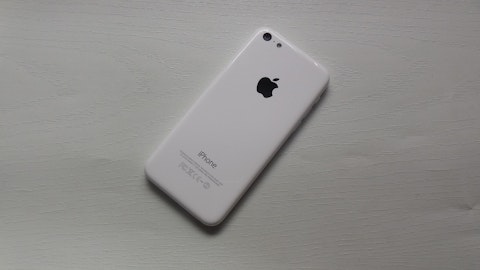What are the best stocks to buy right now? We try to answer this question every day by tracking the moves of smart money and buyside analysts. Sell side analysts usually aren’t independent and their published opinions may be significantly different from their true opinions. This usually isn’t the case with buy side analysts. One of the sources we use to identify investment ideas is checking out the list of stocks financial advisors are searching. Investing Channel’s Intuition publishes a weekly report called Trackstar. According to the latest report covering the February 28th-March 5th period financial advisors’ number one target is Colgate Palmolive Co. (NYSE:CL).
Colgate-Palmolive Co. (CL) is a low volatility stock that has been trading between $50 and $70 in the last 12 months. It has a dividend yield of slightly north of 2.2%. The stock is clearly a flight-to-safety play gaining about 2.5% this year. I glanced over the key statistics of Colgate-Palmolive Co and didn’t really find the stock underpriced. CL’s forward price-earnings ratio is north of 22. It may be a good alternative to long-term bonds but it isn’t the type of stock that can double or triple your money in the next 10 years. Hedge funds don’t like the stock that much. They aren’t short but collectively own only about 3% of its outstanding shares of Colgate-Palmolive.
Intrexon Corporation (NYSE:XON) is the second most popular stock among financial advisors in Trackstar’s list. This small biotech stock garnered more attention than tech giants like Apple and Facebook for an interesting reason. You can read the details here. Intrexon Corporation is one of the best performing stocks this year gaining about 25% year-to-date.
One of the most popular sectors among financial advisors is technology. The top three technology stocks among financial advisors are Apple Inc (AAPL), Netflix (NFLX) and Facebook (FB). Personally I don’t like Apple as a long-term or short-term investment. Before getting into the details, let’s first explain why financial advisors like NFLX and FB. Both of these stocks were among the best performing stocks in 2015 and still garner a lot of attention due to this fact. Nearly one out of every 5 hedge funds has a long position in Facebook.
Hedge funds love Netflix even more based on their 15% economic interest in the stock. However, this doesn’t mean that these two stocks will be good picks in 2016. I should warn you that there are a lot of hedge funds and investors who are very skeptical about Netflix’s surge. The short interest in the stock is also nearly 15%. Here is what David Einhorn said about Netflix last year:
Follow David Einhorn's Greenlight Capital
“On April 15 after the close, Netflix (NFLX) announced its results for the first quarter and conducted a conference call. NFLX shares had already risen 39% in 2015 and were trading at more than 100x 2016 estimates with analysts expecting adjusted earnings for the quarter of $0.63. NFLX achieved just $0.36. Prior to the call, the June quarter consensus stood at $0.86; by the next morning consensus was $0.30. All told, analysts slashed estimates for the next three years. If you’d told us the news in advance, we’d have guessed it was going to be a bad day for NFLX holders, but apparently Red Ink is the New Black. The shares opened the next morning 12% higher and never looked back. By the end of the quarter, the shares had almost doubled for the year, making NFLX the best performing stock in the S&P 500 by far. Why did the stock react that way? Cynically: if it soared on bad news, imagine what it would do with good news. Practically: NFLX changed its story and pushed its promises into the distant future, with grand hopes for the decade starting in 2020. It transitioned from being a company judged by how much it earns into a company judged by how much it spends. Whether the spending proves successful won’t be known during the investment horizon of most NFLX shareholders. In today’s market, the best performing stocks are companies with exciting stories where accountability is in the distant future.”
Now, let’s turn our attention to Apple. I don’t like Apple as a long-term investment at all and explained on CNBC last July why this is the case. At the time Apple shares were trading above $130. Apple is the most widely covered stock in the universe. Everybody knows everything about Apple, so you can outperform other investors only if you are better at analyzing the available information better than other investors. Apple operates in one of the most competitive industries and currently has huge margins which give the consumer goods company a market cap of more than $550 billion. The stock earns about $50 billion a year, so the main question investors answer is really simple. Can Apple retain its huge margins and keep making $50 billion a year for the next 10-15 years? In other words, can Apple trick consumers into paying an extra $200 per phone for the next 10-15 years?
I am not certain but history tells me that this isn’t very likely. Nokia and Blackberry investors paid dearly in the past for their optimistic assumptions. I believe Apple is one recession away from a major correction in its share price. We aren’t currently in a recession, yet Apple is already projecting a revenue decline for the current quarter. Smartphone market is saturated andthe rate of innovation in the industry slowed down significantly. The effects of price competition by low-cost Chinese players haven’t been felt yet but I believe things will change dramatically when US economy goes into a recession.
In the final section of my article I will go back to Trackstar’s weekly report to highlight 3 ETFs. The most popular ETFs among financial advisors were Energy Select Sector SPDR ETF (XLE), iShares 20+ Year Treasury Bond (TLT), and iShares Nasdaq Biotechnology (IBB). Both energy and biotech were among the hardest hit sectors this year and financial advisors were probably betting on a short-term rebound in these stocks. IBB is down about 25% this year whereas XLE is flat because its large exposure to mega-cap energy stocks. Exxon and Chevron together account for more than a third of XLE’s assets. This tells me that it XLE is viewed as a safe bet on a rebound in oil prices. On the other hand TLT is a flight-to-safety play that are favored by investors who are worried about a deterioration in economic growth and expect rates to decline.





